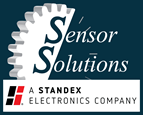- Resource Categories
Sensor Solutions digital Hall Effect Speed and Direction sensors provide two outputs that can be connected to meters, PLCs, and other monitoring and controlling devices to resolve speed and direction or count and direction. This Application Note was created to explain why we build our sensors specific to the pitch (or sometimes refered as pitch module) of the target gear.
HOW DOES A SPEED AND DIRECTION SENSOR WORK?
Speed and direction sensors have two internal sensing elements and two outputs. The first output provides a digital square wave train from one of those elements as gear teeth pass the sensor face. The second output compares the signal from the one sensing element to the other sensing element to switch a digital output high or low dependent on which sensing element sees a tooth of the gear first.
More specifically the direction output utlizes a D flip-flop that compares the output state of one channel to the rising edge of a pulse on the other channel. Dependent on the state of the first channel when the second channel output switches high, the flip-flip outputs either a high or low state.
NOTE: When direction changes with one or both of the sensing elements currently over a gear tooth, the flip flop may not switch until the next tooth passes the sensor. For a truely accurate directional count, a Quadrature Output Gear Tooth Sensor should be paired with an external counter that compares all edges of both output channels to resolve direction.
WHY DOES THE PITCH OF THE GEAR MATTER?
For accurate determination of direction of motion, the two internal sensing elements need to be located relative to each other so that one output will see a passing gear tooth before the other in one direction of rotation. When the direction of rotation changes, the other output needs to see that tooth passing first. For this to happen the outputs need to be both properly offset and produce pulses where the square wave has a similar length of time in the high state as it does in the low state.
- The distance between the two sensing elements determines when they will switch relative to each other. The offset between the outputs is known as the phase angle. If the outputs are not properly offset they could both switch at the same time from two different teeth and the D-flip flop may not register a change in direction.
- The amount of time the square wave output is in the high state as compared to the low state is the Duty Cycle. The ideal duty cycle will be 50% (1/2 the time in each state). The duty cycle is dependent on the length of time the sensor sees the gear tooth relative to the time between the gear teeth.
If the duty cycle is too high or too low the output of the one channel may still be in the wrong state when the rising edge occurs on the other channel. - For more in depth explanation of Phase Angle and Duty Cycle refer to the following Application Note Why Duty Cycle and Phase Angle Matter in Quadrature Speed and Counting Applications
Knowing the pitch of the target gear allows Sensor Solutions to properly space the sensing elements for the best possible phase angle and to calibrate the internal back-biasing magnetic field to provide the best possible duty cycle so that the D flip-flop can properly resolve direction. Although it is possible to produce a speed/direction sensor that will accurately track direction with multiple gear pitches, there will always be exceptions where those sensors will not be able to properly resolve the direction.
Here at Sensor Solutions we want to ensure that the sensors we provide are always the best sensor for the application. This is why we build and calibrate all of our Speed/Direction Gear Tooth Sensors specific to the pitch of the gear being targeted.
If you need additional information related to selecting sensors and targets that best fit your application, we have multiple other Application notes in the index linked below. Or, you can contact Sensor Solutions Application Engineers by phone at 970-879-9900 or use the Contact Us form to send an email.
